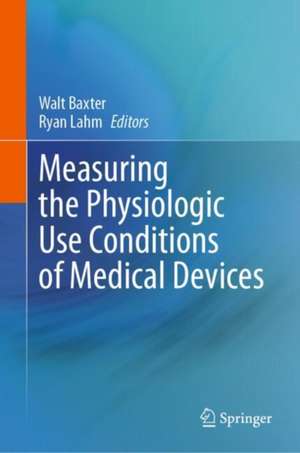Measuring the Physiologic Use Conditions of Medical Devices
Editat de Walt Baxter, Ryan Lahmen Limba Engleză Hardback – 5 oct 2024
- A working definition for the physiologic in vivo use conditions used to further improve medical device performance in patients.
- Introductions to common approaches used to measure medical device use conditions so that engineers can use similar techniques where useful.
- Detailed case studies that highlight problem statements, approaches for measuring physiologic use conditions, and example outputs from such analyses.
Preț: 906.39 lei
Preț vechi: 954.09 lei
-5% Nou
Puncte Express: 1360
Preț estimativ în valută:
173.56€ • 178.84$ • 145.65£
173.56€ • 178.84$ • 145.65£
Carte disponibilă
Livrare economică 31 ianuarie-14 februarie
Preluare comenzi: 021 569.72.76
Specificații
ISBN-13: 9783031627637
ISBN-10: 3031627636
Pagini: 300
Ilustrații: Approx. 300 p.
Dimensiuni: 155 x 235 mm
Ediția:2024
Editura: Springer International Publishing
Colecția Springer
Locul publicării:Cham, Switzerland
ISBN-10: 3031627636
Pagini: 300
Ilustrații: Approx. 300 p.
Dimensiuni: 155 x 235 mm
Ediția:2024
Editura: Springer International Publishing
Colecția Springer
Locul publicării:Cham, Switzerland
Cuprins
Introduction to use conditions for design, test, computational modeling, and procedure development.- Procedural or handling impact on acute and chronic performance (misuse).- Medical images to measure use conditions (CT, MRI, ultrasound, fluoro, x-ray, etc.).- Use condition considerations for lead and catheter design.- Population-based use condition measurement to serve many patients.- Use conditions that impact wireless communication.- Device migration.- Chronic healing response and impact on device performance: the balance of tissue-device interaction.- Flexible device shape history (impact on mechanical reliability).- Relative motion between implanted medical devices.- Measuring deformation/motion cycle counts within a patient population.- Clinical relevance of measurements acquired from pre-clinical models.- The role of returned product and failure analysis as an input to use condition analysis.- Ambulatory measurements i.e. posture-induced movement/loads.
Notă biografică
Walt Baxter is a Distinguished Scientist in the Cardiac Rhythm Management business at Medtronic. Walt’s expertise includes medical device kinematics and deformation in vivo—he used calibrated high-speed cineradiography to make early measurements of implanted cardiac lead deformation. Walt obtained a bachelor's degree in Mechanical Engineering from the Georgia Institute of Technology and a Ph.D. in Bioengineering at the University of California, San Diego.
Ryan Lahm is a Senior Engineering Manager in the Cardiac Rhythm Management business at Medtronic. Ryan is an expert in measuring interactions between medical devices and anatomy—he used some of the first contrast-enhanced volumetric medical images (primarily MRI and CT) to measure how cardiac anatomy interacts with permanently implanted leads and catheters. Ryan obtained a bachelor's degree in Physics from Bethel University and a M.S. in Biomedical Engineering at the University of Minnesota.
Both editors have served patients through their work in the medical technology industry for over 25 years.
Ryan Lahm is a Senior Engineering Manager in the Cardiac Rhythm Management business at Medtronic. Ryan is an expert in measuring interactions between medical devices and anatomy—he used some of the first contrast-enhanced volumetric medical images (primarily MRI and CT) to measure how cardiac anatomy interacts with permanently implanted leads and catheters. Ryan obtained a bachelor's degree in Physics from Bethel University and a M.S. in Biomedical Engineering at the University of Minnesota.
Both editors have served patients through their work in the medical technology industry for over 25 years.
Textul de pe ultima copertă
The physiologic use conditions medical devices are subjected to during implant and long-term in vivo use are critical to ensuring device reliability, efficacy, and safety. This book highlights advanced analyses for measuring the physiologic use conditions of medical devices, introducing important challenges facing engineers. The chapters include:
- A working definition for the physiologic in vivo use conditions used to further improve medical device performance in patients.
- Introductions to common approaches used to measure medical device use conditions so that engineers can use similar techniques where useful.
- Detailed case studies that highlight problem statements, approaches for measuring physiologic use conditions, and example outputs from such analyses.
Caracteristici
A key resource for device engineers who want to understand how medical device use conditions can be measured in vivo Can be used as a supplement to medical device design publications and includes standards for qualification for human use Describes current physiologic use condition investigations and techniques, increasing visibility of this important topic
